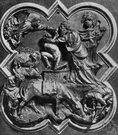18, 404 n.24) by Charles Brewer in "Defrosted Architecture: The Incommensurability of Dufay's 'Nuper Rosarum Flares' and
Brunelleschi's Work far Santa Maria del Fiore," a paper read at the Annual Meeting of the American Musicological Society, Austin, 1989; by Smith, 94; and by Arjan R.
The author brings up, as is usual, the issue of a possible role on the part of
Brunelleschi, but in this case he seems to think that
Brunelleschi's experiments and application of perspective were limited to the two portable pictures we know about (but do not have), and that Pippo did not have the brains nor the will power to extend perspective conceptions to wall painting.
Olson also links this development to broader artistic concerns, such as the architecture of Filippo
Brunelleschi and Gianbattista Alberti, by noting that tondi further reflected the humanism of the Quattrocento and its adulation of the circular form.
At least three circumstances, however, have kept this evident fact from wider acceptance: first, Nanni di Banco worked only in marble; second, he died young, or such at least is the traditional understanding of his career, though, in fact, he lived and worked well beyond his youth; and, third, he was the contemporary of the triumvirate represented by Donatello, Masaccio, and
Brunelleschi. Although Nanni's most famous work, the Quattro Coronati niche on the exterior of Or San Michele in Florence, is conventionally included in surveys of Renaissance art, too often it serves as a foil for the greater naturalism and classicism of Donatello and Masaccio.
After an explanatory review of the substantial literature on the perspective, she goes on to show that Masaccio's and
Brunelleschi's space was calculated according to the many projection techniques of late-medieval astronomers.
The modernist eye, following the rule of "form follows function" admired, for instance, the clarity and severity of
Brunelleschi's Old Sacristy, forgetting that contemporaries appreciated that building more for (in the words of Niccolo de' Carissimi) its "porphyry and glass and various marbles" (155).
The Blacks, led by the Donati, included the Spini, Pazzi, della Tosa, Visdomini, Bardi, Rossi,
Brunelleschi, Tornaquinci, Manieri, Buondelmonti, Bostichi, and Franzesi.
 Brunelleschi - Florentine architect who was the first great architect of the Italian Renaissance (1377-1446)
Brunelleschi - Florentine architect who was the first great architect of the Italian Renaissance (1377-1446)